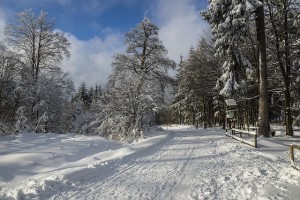 Print a Sign-In Sheet | Spanish Version
Print a Sign-In Sheet | Spanish Version
One of the most terrifying experiences in winter driving is the skid. If a skid happens at high speed, the result can be a disastrous crash. It is imperative that you slow down at the first sign of a slick roadway. Most skids can be avoided by adjusting to the conditions, and it is possible to recover from skids if you know how.
Here are several tips on driving in winter weather:
- As skids are likely on curves and turns, slow down prior to entering a curve or turn, and apply power slightly into the curve. Steering should be steady with no abrupt change in direction and, especially, no abrupt braking.
- Plan for lane changes. Check your mirrors, check your blind spots, and signal to traffic your intentions to change lanes, then swing over in a long, gradual change. Make the move with the smallest possible steering change and with a light foot on the gas pedal.
- If you go into a skid, remember two cardinal rules—don’t steer against the skid and don’t hit the brakes. Instead, steer in the direction the vehicle is sliding until you feel recovery of traction, then slowly straighten the wheels and keep rolling.
- If braking is necessary before rolling traction is recovered, apply the brake pedal carefully so as not to lock the wheels and intensify the skid.
- The careful driver is constantly on the lookout for areas that might induce skidding, such as unexpected ice patches or piles of wet leaves often found in shady areas or on overpasses. Keep in mind that wet ice warmed by the sun is more treacherous than “cold” ice.
- Above all, the expert driver knows that a safe stop on icy or snow-packed roads is a tricky maneuver that requires skill and good judgment. Anticipate stops and slow down gradually well ahead of intersections, conscious of the fact that approaches to stopping places are apt to be polished and slick because of stopping and starting traffic.
- Because accidents are common in winter, a careful driver makes a double allowance for the sake of safety. First, drive on slippery roads at reduced speed. Second, increase following distance behind the vehicle ahead. This gives an extra space cushion for safe stopping in case there is trouble.
- Traction, as every driver probably knows, could be the difference between winter and summer driving. Drivers should learn how to get the best possible traction when the roadway is slippery.
- When you drive into deep snow, you may find that stepping on the gas only provides a spinning of the wheels with little, if any, forward movement. In such cases, one should avoid overpowering. A light foot on the gas pedal and a high gear is preferable.
- If you get stuck in deep snow, you may only spin your wheels in trying to get out. Sometimes it helps to twist the steering wheel back and forth to push away snow in front, and then try again—lightly. A sprinkling of sand or light gravel in front of drive wheels or a traction mat of wire mesh or a strip of carpet may be necessary.
- Braking distance depends directly upon the contact a vehicle’s tires make with the surface of the road. Your tires should have good tread surfaces. There will be times that snow tires, and even chains, may be best to help keep your vehicle under control during those blustery winter storms.
KEMI does not assume liability for the content of information contained herein. Safety and health remain your responsibility. This information is to be used for informational purposes only and not intended to be exhaustive or a substitute for proper training, supervision, or manufacturers’ instructions/recommendations. KEMI, by publication of this information, does not assume liability for damage or injury arising from reliance upon it. Compliance with this information is not a guarantee or warranty that you will be in conformity with any laws or regulations nor does it ensure the absolute safety of any person, place, or object, including, but not limited to, you, your occupation, employees, customers, or place of business.

